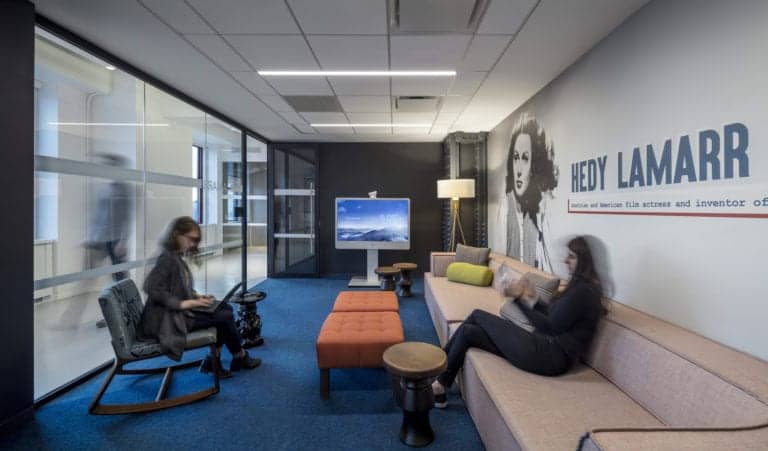More...
By Julie Maggos, SEGD, LEED AP | Senior Director of Experiential Graphics | May 23, 2017
HOW TO TELL YOUR BRAND’S STORY THROUGH WORKPLACE DESIGN.
Once upon a time, an organization wanted to appeal to new and existing clients, while inspiring both employees and recruits. They had an excellent product, offered quality service, and leveraged their brand power well through their public persona. The one place it hadn’t considered as part of its brand arsenal was its own workplace.
Research from employee surveys is clear: The role of a company’s brand and how it contributes to the workplace in terms of mission, values, culture, and work environment is a top factor considered by job seekers. Yet 87% of organizations cite culture and engagement as one of their top challenges. While most companies work hard to define their brand externally, it’s a mistake to neglect the environment and culture of their employees.
How can an employer leverage the workplace to highlight brand, build pride, attract future talent, and foster collaboration and engagement? What are the key factors to consider?
Brand
For employees to embrace their company’s culture and mission, they must clearly understand the brand they are dedicated to building through their work. Weaving specific brand stories into the design of the work environment via experiential graphics is one way to accomplish this. Brand stories can address a company’s history, values, vision, featured clients, projects, or products. How the stories are designed and executed is, of course, unique to each location and company, and this is what IA’s integrated approach, including experiential graphics expertise, helps clients accomplish.

At this confidential client’s headquarters in Chicago, a key brand message glows in neon at the coffee bar. Photo by Darris Lee Harris
Messaging through the use of experiential graphics can influence perception, motivation, and the behavior of employees and visitors alike by aligning the interior design with an organization’s brand.
Culture
In addition to integrating specific brand messages, it is equally important to feature stories, artifacts, and displays that are significant to the users of the space. Examples of this can be as simple as a wall in a break room that houses tchotchkes brought back by employees from their travels. Or it can be as ambitious as a wall of employee polaroids tacked up next to digital displays of photos from volunteer events.
Culture can be encouraged or ignored, but it cannot be forced. The secret is understanding the current culture–what connects people and creates excitement–and cultivating positivity within the workplace. Employees desire emotional engagement with their organizations.

In the employee cafe at this confidential client in New York, a wall of Rubix cubes invites collaboration to continuously update the design. Photo by Magda Biernat
Place
The final category of expression in our tale is location. Where is a company located, and why is that important to users? Many organizations strive to highlight their global reach. Others may want to focus on national, local, or even hyper-local settings such as neighborhood or team level.
It is important to focus on the difference between external-facing versus internal-facing messages. For instance, if an organization wants to showcase its global locations with a map, the best place for the maps may be in a public-facing area such as reception so that visitors get the message. However, employees who come to work every day may want more specific information directed to them in the work environment. A tackable map of the nearby neighborhood, for example, could be used to share recommendations for the best local haunts.

An employee hub at the office of a financial services provider in Washington, DC is inspired by Union Station: finishes, light fixtures, and panel graphics featuring East Coast train lines tell the story. Photo by Thomas McConnell
Every business needs a great story to engage customers and employees alike. Whether companies use words, pictures, or something more abstract, storytelling in the workplace reminds employees why they do what they do. Experiential graphics play a significant role in determining how a company communicates who they are, the kind of workplace environment they value, and the quality of the user experience of those who work there.
Like What You See?
Click below to learn more about IA's approach to experiential graphics!
The workplace is an open book - what story is it telling?


